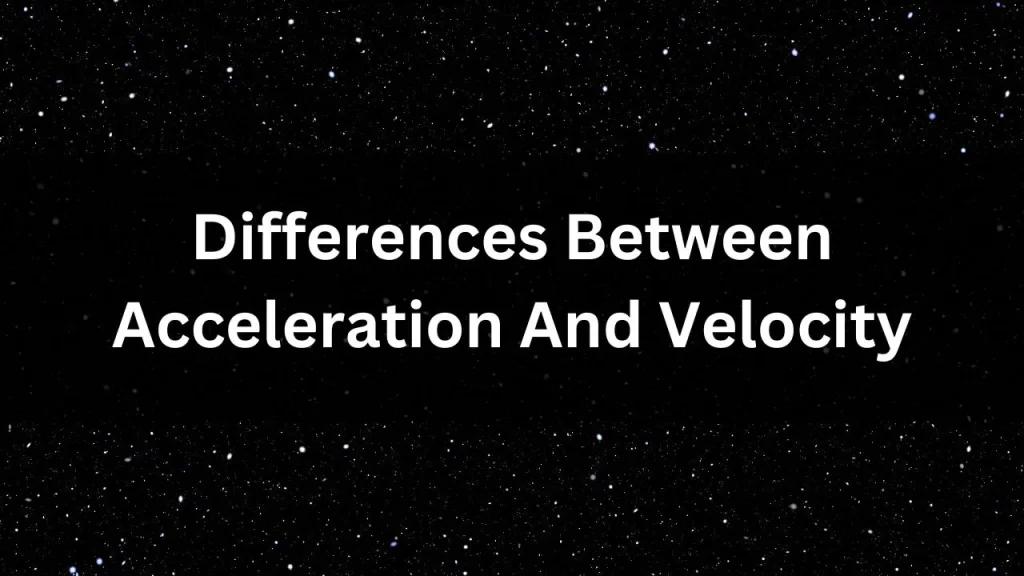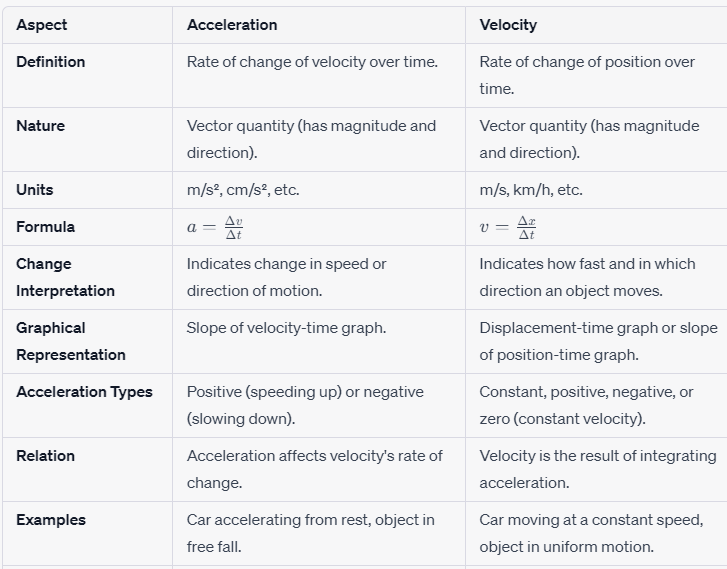Tag: Differences Between Acceleration And Velocity
Differences Between Acceleration And Velocity
Differences Between Acceleration And Velocity: Physics is a field that describes and explains the fundamental principles governing the behavior of the universe.

In the realm of mechanics, two key concepts are often discussed: acceleration and velocity. While they both relate to the motion of objects, they represent distinct aspects of an object’s movement and carry different meanings and implications.
This article aims to elucidate the differences between acceleration and velocity, highlighting their definitions, units, calculations, and real-world applications.
Differences Between Acceleration And Velocity

1. Definition and Nature:
Velocity refers to the rate of change of an object’s position concerning time. It is a vector quantity, which means it has both magnitude (numerical value) and direction. In simple terms, velocity informs us how fast an object is moving and in which direction it is headed.
Acceleration, on the other hand, signifies the rate of change of an object’s velocity concerning time. It is also a vector quantity, encompassing magnitude and direction. Acceleration portrays the change in an object’s speed or the alteration in its direction of motion.
2. Units:
Velocity is typically measured in units of distance divided by units of time, such as meters per second (m/s), kilometers per hour (km/h), or even feet per second (ft/s) depending on the context.
Acceleration is measured in units of change in velocity divided by units of time. Common units include meters per second squared (m/s²) and centimeters per second squared (cm/s²).
3. Calculations:
To calculate velocity, you can use the following formula:
Velocity(v) = Change in position(Δx)/Change in time(Δt)
For acceleration, the formula is:
Acceleration(a)=Change in velocity(Δv)/Change in time(Δt)
4. Relationship:
Velocity and acceleration are related in the sense that acceleration affects the change in velocity. When an object undergoes a constant acceleration, its velocity changes uniformly over time. If an object is accelerating in the same direction as its initial velocity, it speeds up. If it’s accelerating in the opposite direction, it slows down.
5. Real-World Examples:
Imagine a car accelerating from a standstill at a traffic light. Initially, the car’s velocity is zero because it’s not moving. As the car accelerates, its velocity increases in the direction of motion. This increase in velocity signifies positive acceleration.
Now, consider a car braking to come to a stop. As the driver presses the brakes, the car’s velocity decreases until it comes to a complete halt. This decrease in velocity denotes negative acceleration, often referred to as deceleration.
6. Graphical Representation:
Velocity and acceleration can be graphically represented over time. A velocity-time graph would show a slope corresponding to the acceleration. A constant slope indicates constant acceleration, while a changing slope signifies changing acceleration.
An acceleration-time graph would depict the rate of change of velocity over time. The slope of this graph represents the actual acceleration.
Newton’s Second Law of Motion
Newton’s Second Law of Motion is a fundamental principle in classical mechanics that establishes the relationship between the net force acting on an object, its mass, and the resulting acceleration. It states that the accel. of an object is directly proportional to the net force applied to it and inversely proportional to its mass. Mathematically, this law is expressed as:
Where:
- represents the net force applied to the object.
- is the mass of the object.
- signifies the resulting acceleration.
This law highlights that when an external force is applied to an object, it causes the object to accelerate in the direction of the force. Additionally, the greater the force applied, the greater the resulting acceleration, provided the mass remains constant. Conversely, if the mass increases while the force remains constant, the acceleration decreases.
Newton’s Second Law also encapsulates the concept of inertia, which is an object’s resistance to changes in its state of motion.
Objects with larger masses exhibit greater inertia, requiring more force to produce the same acceleration as objects with smaller masses.
This law provides a foundational framework for understanding and predicting the behavior of objects in motion under the influence of external forces.
Conclusion:
In the realm of physics and mechanics, the concepts of velocity and acceleration play crucial roles in describing and understanding the motion of objects.
While velocity reveals the speed and direction of an object’s movement, acceleration reveals how that velocity is changing over time.
These distinctions are vital for comprehending the complexities of motion and form the foundation for various scientific and technological advancements.
Whether you’re observing a rocket launch, calculating the motion of planets, or designing safer vehicles, a clear grasp of the differences between acce. and velocity is essential.
Read Also
- Matter In Our Surroundings Class 9 Summary
- Class 9th Chapter 2 Science Question Answer of NCERT
- NCERT Physics Class 9 Chapter 1 Solutions PDF Download
- CBSE Previous Year Question Papers Class 9 Science
Frequently Asked Question – FAQs on Differences Between Acceleration And Velocity
What is the fundamental difference between acceleration and velocity?
The fundamental difference lies in their definitions. Velocity is the rate of change of an object’s position concerning time and includes both speed and direction. Acceleration is the rate of change of an object’s vel. over time, indicating how much an object’s speed or direction of motion is changing.
Are velocity and acceleration scalar or vector quantities?
Both velocity and acceleration are vector quantities. This means they have both magnitude (numerical value) and direction.
How are velocity and acceleration units measured?
Velocity is measured in units of distance divided by units of time, such as meters per second (m/s) or kilometers per hour (km/h). Acceler. is measured in units of change in vel. divided by units of time, such as meters per second squared (m/s²).
Can an object have constant velocity and still be accelerating?
No, constant velocity implies that an object is moving at a steady speed in a straight line without changing direction. Acce. indicates a change in velocity, either in terms of speed or direction.
What does positive acceleration mean?
Positive acceleration occurs when an object’s vel. is increasing over time. It could mean the object is speeding up in the same direction as its initial motion or slowing down in the opposite direction.